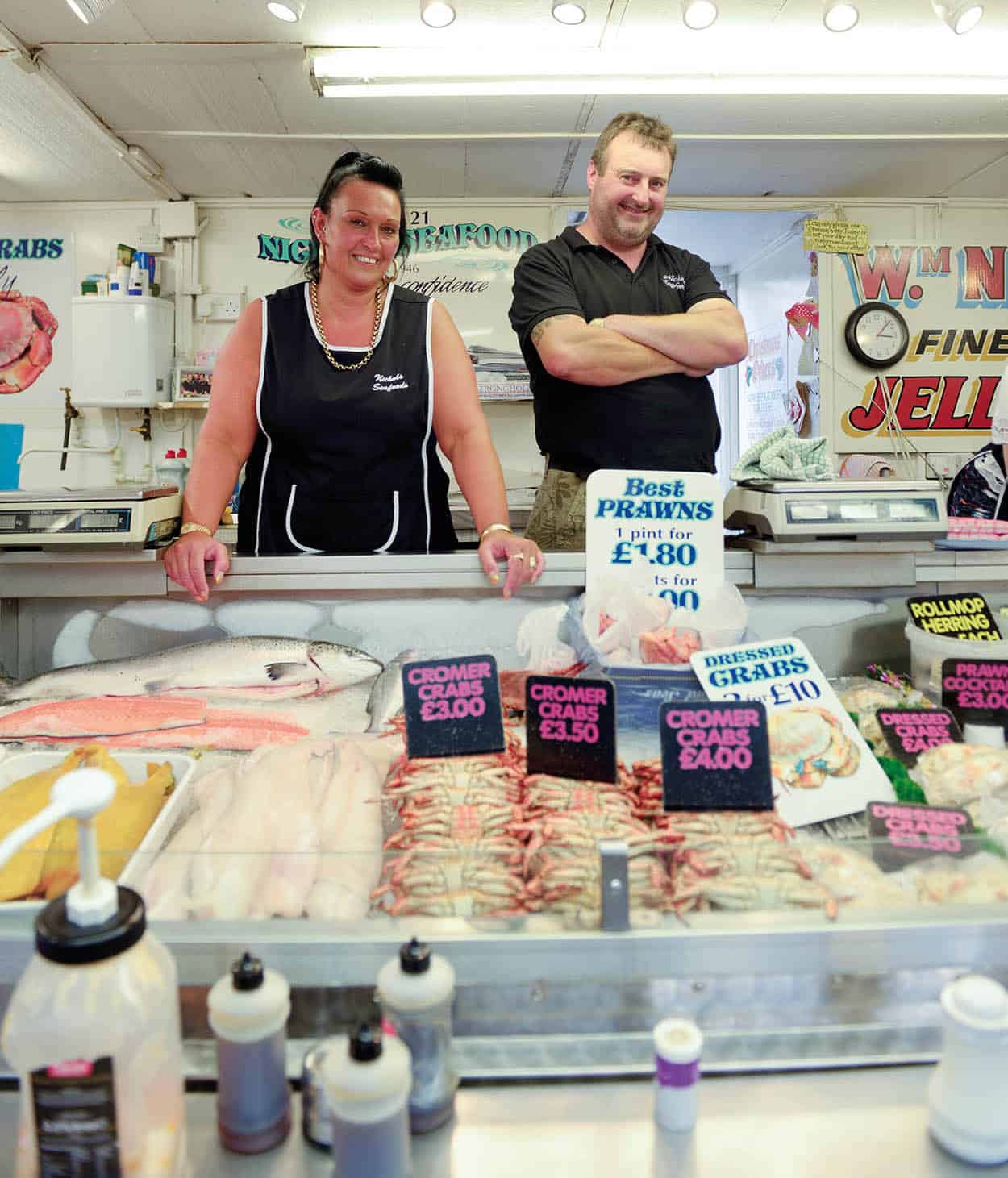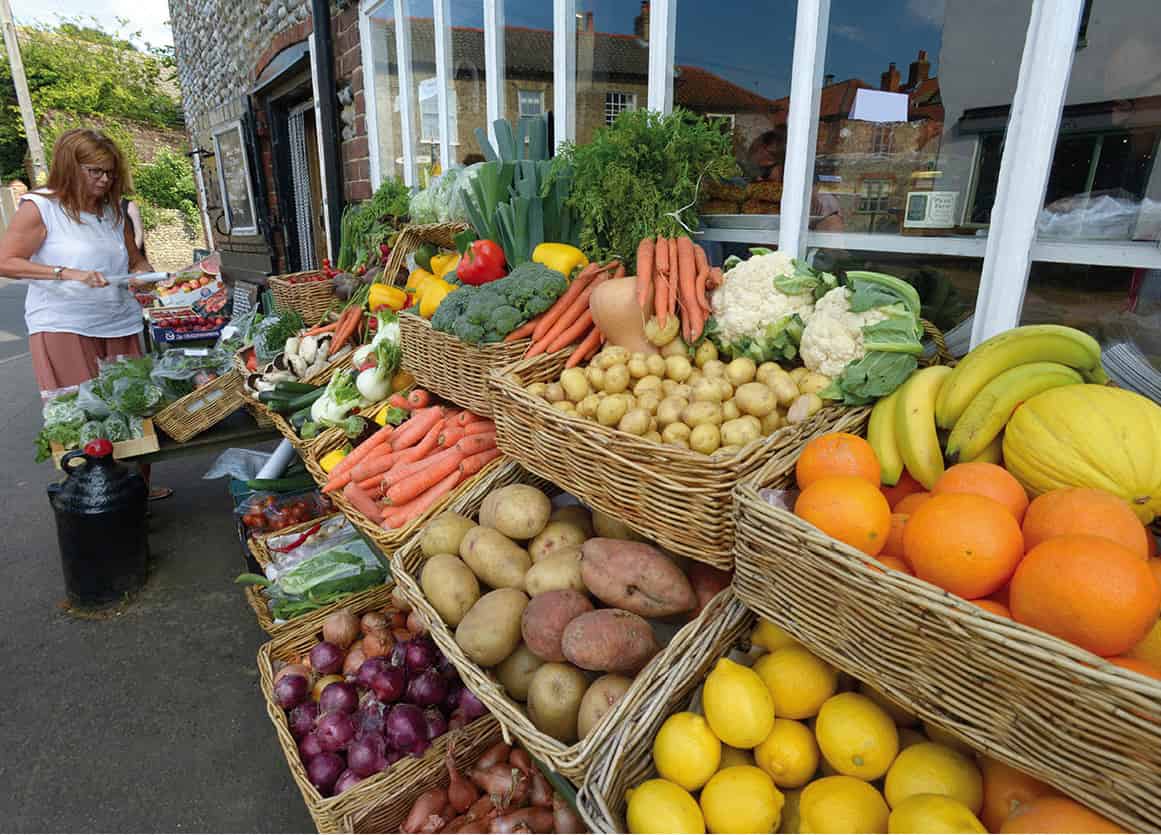The last quarter century has seen a transformation of the food and drink scene in Norfolk and Suffolk, thanks to the demand for specialist local producers and the more discerning tastes of holidaymakers.
Thanks to its climate, rich soil and diverse coastline, East Anglia lives up to its reputation as ‘the breadbasket of Britain’. Both Norfolk and Suffolk have a field-to-fork philosophy – the idea that food can make its way from the ground to your plate without leaving the county. An encouraging number of gastropubs and restaurants put this philosophy into practice, their menus featuring local fare, whether it’s pork from Blythburth, venison from the Suffolk Denholm estate, smoked fish from Orford, crab from Cromer or oysters from Brancaster. Menus often inform you exactly where the produce is sourced. A prime example is The Bildeston Crown, Bildeston, whose Red Poll beef, Suffolk lamb and many of the vegetables they serve come from their own farm.

Cromer crab and fish stall in Great Yarmouth.
Sylvaine Poitau/Apa Publications
It’s not just the food that’s home grown. The chances are that your choice of restaurant or pub will be serving real ales and beers from one of the many local micro-breweries. The long-established Adnams in Southwold supplies establishments throughout East Anglia – and well beyond – while Norfolk, which claims to have the best malting barley in the country, has more micro-breweries than any other county in the UK. To top it off, the Suffolk family-run firm of Aspall have been brewing a range of excellent ciders since 1728.
Many of Suffolk and Norfolk’s ancient market towns hold a weekly or monthly farmers’ market selling locally made cheeses, artisan bread, ready-to-cook wild game and fresh fish and seafood. Among the best are Snape Maltings, Bury St Edmunds, Lavenham, Sudbury, Swaffam and Creake Abbey.
Fruits of the sea
The fishing scene is not what it was. Lowestoft no longer has a fishing fleet and the silting up of harbours on the North Norfolk coast led to the decline of formerly thriving fishing ports. But crab-catching still goes on in Cromer, mussels are harvested at Brancaster and oysters come from the creeks around Orford. Samphire, otherwise known as ‘sea asparagus’ thrives in the north Norfolk salt marshes. At Aldeburgh fishermen still land skate, seabass and Dover sole, selling it from shacks on the shingle beach. Stiffkey on the north Norfolk coast is traditionally famous for cockles, known as Stewkey Blues on account of their distinctive grey-blue shells. The cockles are harvested with broad rakes and nets, then steamed or put in soups and pies, although today’s cockles are more likely to come from King’s Lynn.
The sweet tender Cromer crab is justly famous. These small crustaceans thrive on the chalk reef just off Cromer. No one knows exactly why they’re so good (they are the same species as other British crabs) but it is generally thought to be the slow speed with which they grow. Crabbing boats, of which there are now only around a dozen at Cromer, go out to lay pots about three miles offshore from March to October. Try the dressed crab at Davies Fish Shop in Garden Street, Cromer. The legendary Davies family go back four generations as lifeboatmen and fishermen. They have their own boat and you can be assured their seafood is as fresh as you’ll get. For a bit of extra excitement, head to Cromer on August Bank Holiday Sunday for the World Crabbing Championships.
Delis and farmshops
SUFFOLK
Emmett’s, Peasenhall (www.emmettsham.co.uk). Suffolk hams and bacon made the traditional way since 1820.
Lawson’s Delicatessen, Aldeburgh (www.lawsonsdelicatessen.co.uk). Award-winning deli.
Suffolk Food Hall, Wherstead, near Ipswich (www.suffolkfoodhall.co.uk). Butcher’s, deli, fishmonger, bakery and more all under one roof.
NORFOLK
Farm to Fork and Fish, Horstead (www.farmtoforkandfish.co.uk). Fresh, seasonal and local produce.
The Galley, 43 Lower Street, Horning (www.thegalley-horning.co.uk). Family-run deli, café and gift shop.
Picnic Fayre, Cley-next-the-Sea (www.picnic-fayre.co.uk). Deli with homemade produce, fruit and veg and local products.

Fresh fruit and veg at Picnic Fayre in Cley-next-the-Sea.
Sylvaine Poitau/Apa Publications
Aldeburgh food and drink festival
An increasing number of food festivals are taking place but there is none to match Aldeburgh’s, which is a two-day extravaganza in late September in the halls and marquees of Snape Maltings, celebrating the quality and bountiful harvest of the East Suffolk countryside. This is where you can rub shoulders with well-known chefs, meet butchers, bakers and farmers showcasing their produce, attend bread-making sessions, go foraging for nuts and mushrooms or join a tutored wine-tasting session. The event then spreads through the region with farm walks, tastings and workshops across the county for the following fortnight.
Eating Out Price Guide
Two-course meal for one person, including a glass of wine.
£££ = over £30
££ = £20–30
£ = under £20